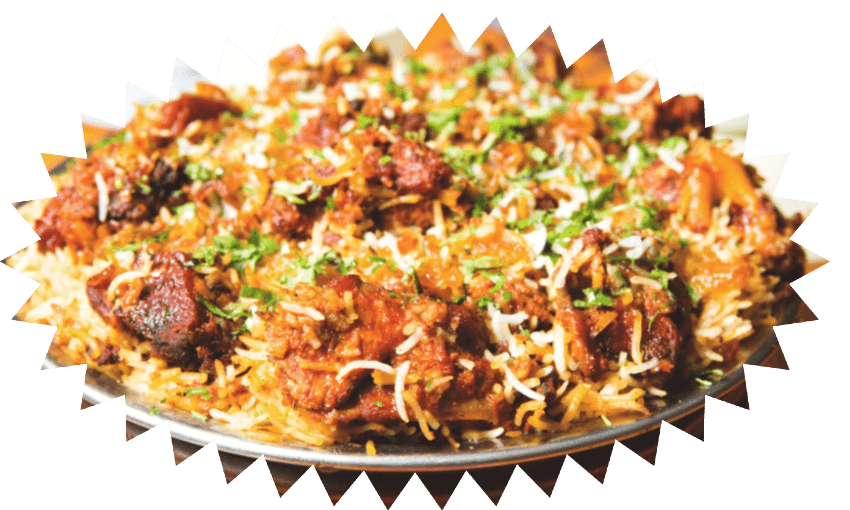Perzen Patel on the iconic dish that both unites and divides India.
Friday nights are takeaway nights in my household – there’s simply not enough steam in the parent engine to cook one more meal. The challenge, of course, is ordering something that everyone will eat. Last year, I cracked it: we started ordering biryani.
The fluffy, yellow-tinged aromatic rice at the top, sitting among a bed of boiled eggs, was perfect for my spice-hating toddler. The juicy, almost-falling-apart pieces of lamb loved by my “I need to eat meat everyday” husband. As for me, there’s nothing that satisfies my Indian soul more than a bowl of rice. But what I loved the most was that there’s almost always enough leftovers for Saturday lunch. One more meal conundrum solved!
A celebration of all that’s great about Indian food
Growing up, biryani was not something we ate regularly or cooked at home. That’s because it tastes best when cooked slowly, ideally in a large copper handi over a wood fire. Imagine: a heady aroma of whole spices slow-cooking, the vibrant colour of marinated meat cooking in its own juices, and long grains of rice bringing everything together. Digging around a big pot of biryani for that perfectly succulent piece of lamb before someone else steals it. Not quite the same experience when cooked at home in small quantities.
My grandpa, the OG food connoisseur, taught me that if there was a party worthy of biryani, it had to be ordered from Jaffer Bhai’s Delhi Darbar on Grant Road, Mumbai. While Jaffer Bhai – fondly known as the Biryani King of Mumbai – passed away in 2020, his restaurant established in 1973 continues to serve biryani that’s consistently out of this world.
A dish that both unites and divides
It’s widely believed that biryani has its origin in Persia, and was introduced to the Indian subcontinent by the Mughals. Legend has it that Queen Mumtaz Mahal once visited her army troops only to find out the soldiers were undernourished, so she asked the cooks to create a dish that featured both meat and rice and what originated was biryani. Lucknow, a city in Uttar Pradesh, claims to be the home of biryani – though in typical Indian fashion, so do Kolkata and Hyderabad.
In a country where the food you eat changes every 100km, biryani is a dish we all eat, and one that continues to evolve. Hyderabadi, Mumbai, Awadhi, Thalasserary – there are so many different styles of biryani to choose from. It’s a dish that both unites and divides and is the source of endless debates. Go to any Indian party and you’ll find a middle-aged uncle or aunty making the case for how the biryani they ate from such-and-such place is actually the best one there is.
Is vegetarian biryani still biryani?
Biryani’s signature flavour comes from its “pakki-dum-pukht” style of cooking. Dum pukht literally translates to “breathe and cook” in Hindi and pakki stands for ripe or already cooked. Unlike pulao, where both meat and rice are cooked together, biryani is layered.
The meat goes in first, followed by a layer of fried shallots and saffron water – and fried cashews if you want to go all out – which is followed by rice. When cooking for big crowds, the layers would be repeated twice or even thrice depending on the depth of your utensil before being sealed with a simple dough and being slow-cooked a final time. The idea is that the steam produced by the layers of meat gravy rise, further tenderising the meat and rice, and then condenses, keeping everything in the pot from drying out.
Does that still work if there is no meat and therefore no meat stock? This is another area that’s up for debate. One camp maintains that biryani made without meat is most definitely pulao, while the other soldiers on making all sorts of variations cooking biryani with vegetables and sometimes with egg or even paneer.
Cooking biryani at home
I’m not sure why I resisted making biryani at home for so long – probably it’s the long ingredient list and multiple stages of cooking. Also, I have no patience for making a dough that’s solely used to seal steam.
If you want to make a biryani that’s as close as possible to the real thing, you can’t escape the multiple stages of cooking – but there are some hacks to make life easier. Mine is to buy pre-marinated tandoori lamb from my local Pakistani butcher, to which I simply add some ginger-garlic paste and yoghurt. From the same butcher, I’ll often hunt for Shan Biryani Masala, which has a cult following in India. Finally, instead of fussing with the dough, I layer my biryani in my dutch oven or seal using foil.
Not quite like Jaffer Bhai’s – but still tasty enough to pass the uncle-aunty test.
Finding a good biryani in Aotearoa
There are plenty of places to grab a good bowl of biryani across the country, with many Indian restaurants offering family packs – make sure you ask for the special pack which comes with a side serving of chilli chicken and boiled eggs.
With both Paradise and Bawarchi on the same street, Sandringham in Auckland is always a good place to start. Discerning Indian foodies (including aforementioned aunties and uncles) will tell you that Ace Caterer’s Akbari serves up the real deal, too.
Alternatively, if you’re ready to cook biryani at home, my small business Dolly Mumma offers a ready-to-cook Biryani Box to help you cook tasty biryani easily no matter where you are.





